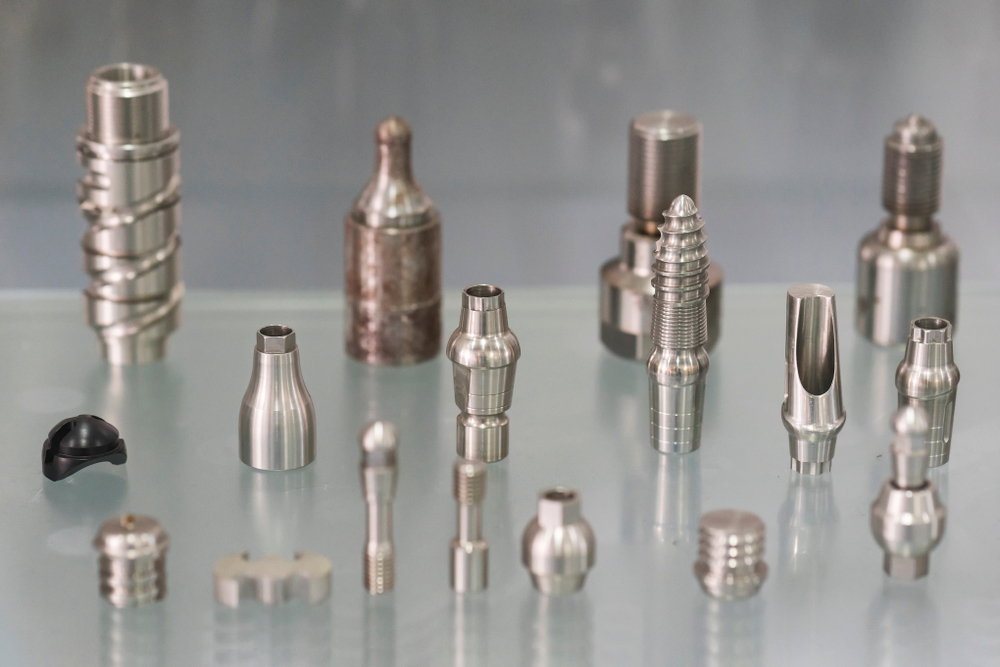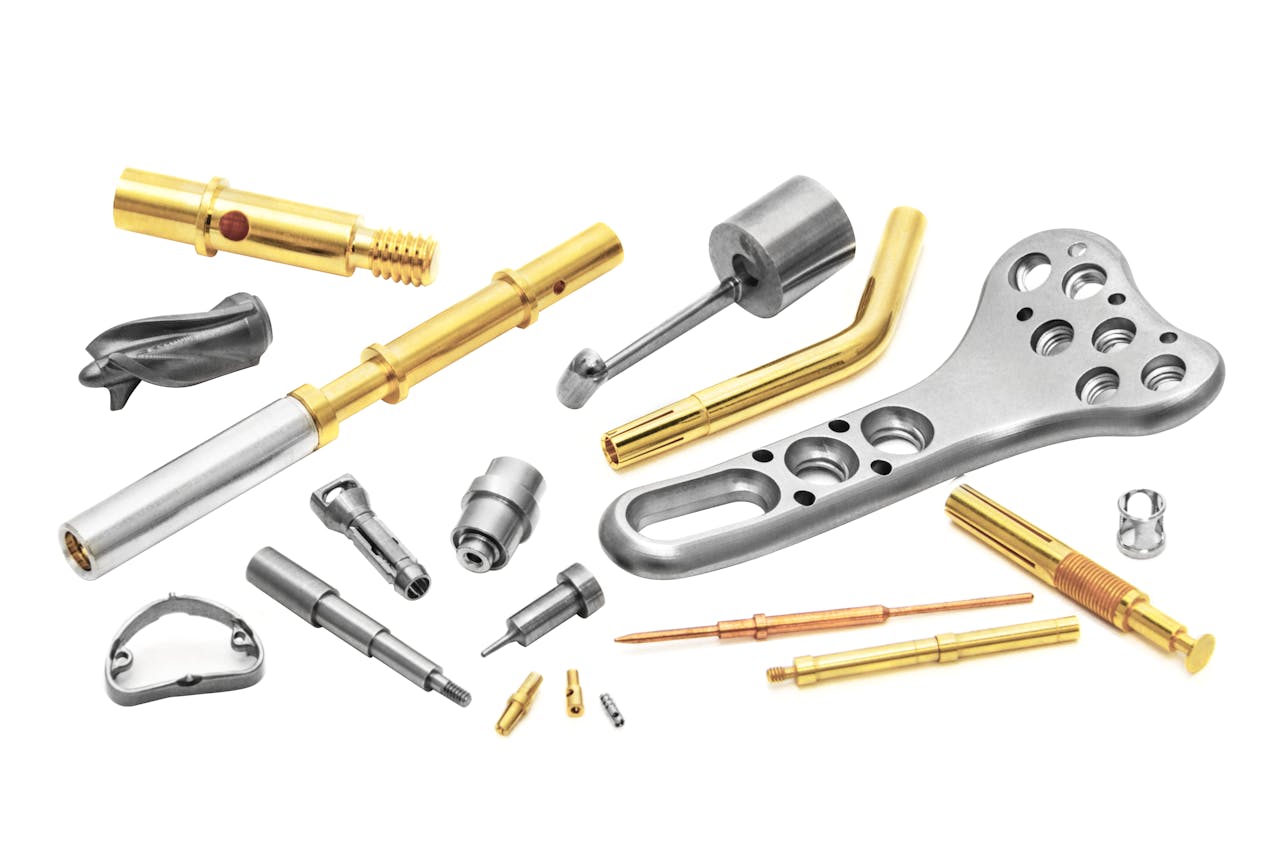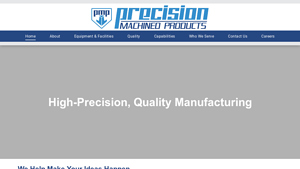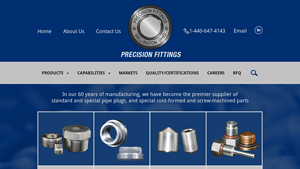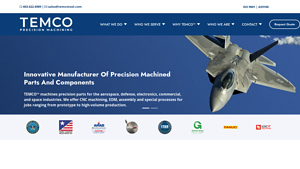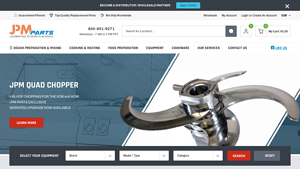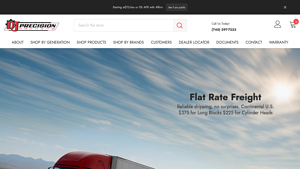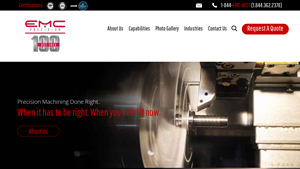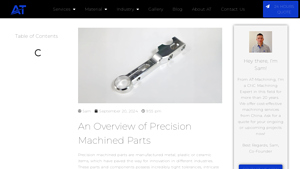Precision Machine Parts Guide: Type, Cost, Top List…
Introduction: Navigating the Global Market for precision machine parts
In an increasingly interconnected global economy, sourcing precision machine parts presents a unique set of challenges for international B2B buyers. Navigating the complexities of quality assurance, compliance with regional standards, and cost management can be daunting. This guide aims to demystify the process of acquiring precision machine parts, offering insights into various types, their applications across industries, and the critical factors to consider when vetting suppliers.
From understanding the nuances of different machining processes to evaluating the total cost of ownership, this comprehensive resource equips decision-makers with the knowledge necessary for informed purchasing. The guide delves into the specifics of sourcing strategies, ensuring that buyers from diverse regions—including Africa, South America, the Middle East, and Europe—can confidently engage with suppliers that meet their unique requirements.
With a focus on actionable insights, this guide empowers businesses to optimize their procurement processes, reduce lead times, and enhance product quality. By leveraging the information contained within, B2B buyers can navigate the global market for precision machine parts more effectively, leading to smarter, more strategic purchasing decisions that foster long-term growth and innovation.
Understanding precision machine parts Types and Variations
| Type Name | Key Distinguishing Features | Primary B2B Applications | Brief Pros & Cons for Buyers |
|---|---|---|---|
| CNC Machined Parts | High precision, automated machining, complex geometries | Aerospace, automotive, medical devices | Pros: High accuracy and repeatability; Cons: Higher initial costs. |
| Injection Molded Components | Molded from thermoplastics or metals, complex shapes | Consumer products, automotive, electronics | Pros: Cost-effective for large volumes; Cons: Initial mold costs can be high. |
| Precision Fasteners | Various shapes and sizes, engineered for specific loads | Industrial machinery, construction, automotive | Pros: Ensures reliability; Cons: Sourcing can be complex. |
| Custom Fabricated Parts | Tailored designs, made from various materials | Heavy machinery, specialized equipment | Pros: Meets specific needs; Cons: Longer lead times. |
| Precision Fittings | Designed for specific applications, often standardized | Plumbing, HVAC, automotive | Pros: Ensures compatibility; Cons: Limited to specific applications. |
What Are CNC Machined Parts and Their B2B Benefits?
CNC (Computer Numerical Control) machined parts are created using automated machines that follow precise specifications to produce complex geometries. These parts are essential in industries such as aerospace and automotive, where precision and reliability are paramount. When purchasing CNC machined components, B2B buyers should consider the machine’s capability, tolerances, and material options. While the initial costs may be higher, the long-term benefits of accuracy and repeatability often justify the investment.
How Do Injection Molded Components Serve Various Industries?
Injection molded components are produced by injecting molten material into a mold, allowing for intricate designs and high-volume production. This process is widely used in consumer products, automotive parts, and electronics. For B2B buyers, the key considerations include the cost-effectiveness of large runs versus initial mold costs, as well as the material properties required for the final product. While injection molding can be cost-effective, buyers must balance upfront investment with long-term production needs.
Why Are Precision Fasteners Critical in Industrial Applications?
Precision fasteners are engineered components designed to hold parts together securely under specific loads. They are commonly used in industrial machinery, construction, and automotive applications. B2B buyers should focus on the fastener’s material, load specifications, and compatibility with existing components. While precision fasteners offer reliability and performance, sourcing can become complex, especially for specialized applications, which may impact lead times and costs.
What Are the Advantages of Custom Fabricated Parts in Specialized Equipment?
Custom fabricated parts are tailored to meet specific operational requirements and can be made from a variety of materials, making them invaluable in heavy machinery and specialized equipment. Buyers looking for custom solutions should assess the manufacturer’s capabilities, turnaround times, and material options. While custom fabrication can provide a perfect fit for unique applications, it often comes with longer lead times and higher costs compared to standard solutions.
How Do Precision Fittings Ensure Compatibility in Systems?
Precision fittings are designed to connect various system components, ensuring proper flow and function in plumbing, HVAC, and automotive systems. B2B buyers should prioritize compatibility with existing systems and the specifications required for their applications. While precision fittings guarantee a reliable connection, their application-specific nature may limit versatility, necessitating careful consideration during procurement to avoid mismatches.
Key Industrial Applications of precision machine parts
| Industry/Sector | Specific Application of precision machine parts | Value/Benefit for the Business | Key Sourcing Considerations for this Application |
|---|---|---|---|
| Aerospace | Engine components and structural parts | Enhanced performance and safety standards | Certification requirements, material specifications, and lead times |
| Automotive | Transmission systems and engine parts | Improved efficiency and durability | Quality assurance processes and compatibility with existing systems |
| Medical Devices | Surgical instruments and diagnostic equipment | High precision and reliability | Regulatory compliance, biocompatibility, and traceability |
| Oil & Gas | Valve components and drilling equipment | Increased operational efficiency and safety | Material selection for harsh environments and adherence to industry standards |
| Industrial Machinery | CNC machines and assembly line components | Increased productivity and reduced downtime | Customization capabilities and supply chain reliability |
How Are Precision Machine Parts Utilized in the Aerospace Industry?
In the aerospace sector, precision machine parts are vital for manufacturing engine components and structural parts. These components must meet stringent performance and safety standards due to the critical nature of aerospace applications. Buyers in this industry often seek suppliers who can provide parts that are not only precise but also compliant with aviation regulations. Sourcing considerations include the need for certifications like AS9100 and adherence to material specifications that ensure durability and lightweight characteristics.
What Role Do Precision Machine Parts Play in the Automotive Sector?
In the automotive industry, precision machine parts are integral to the production of transmission systems and engine components. These parts are designed to improve the efficiency and durability of vehicles, addressing challenges such as wear and tear from high-stress environments. International buyers should consider suppliers that have robust quality assurance processes in place to guarantee compatibility with existing systems, as well as the ability to meet specific performance standards.
How Are Precision Machine Parts Essential for Medical Devices?
Precision machine parts are crucial in the medical device industry, particularly for surgical instruments and diagnostic equipment. The high level of precision required in these applications ensures reliability and safety for patients. Buyers must prioritize suppliers who adhere to stringent regulatory compliance and can provide documentation for biocompatibility and traceability. This is especially important for international buyers navigating varying regulations across different regions.
Why Are Precision Machine Parts Important in Oil & Gas?
In the oil and gas sector, precision machine parts are essential for manufacturing valve components and drilling equipment. The harsh environments these parts operate in require materials that can withstand extreme conditions while maintaining operational efficiency. Buyers should focus on sourcing parts that meet industry standards and are designed for safety, as failures can lead to significant operational risks. Material selection and adherence to industry-specific standards are critical sourcing considerations.
How Do Precision Machine Parts Enhance Industrial Machinery?
Precision machine parts are used extensively in industrial machinery, particularly in CNC machines and assembly line components. These parts enhance productivity and reduce downtime by ensuring smooth operation and quick changeovers. Buyers need to consider suppliers that offer customization capabilities to meet specific production needs and ensure supply chain reliability to avoid delays in manufacturing processes. This is particularly important for companies looking to maintain competitive advantages in fast-paced markets.
3 Common User Pain Points for ‘precision machine parts’ & Their Solutions
Scenario 1: Delays Due to Inaccurate Specifications
The Problem: B2B buyers often face significant challenges when specifications for precision machine parts are not accurately defined or communicated. This lack of clarity can lead to delays in production, increased costs, and strained supplier relationships. For example, if a manufacturer requires custom machined components but fails to provide precise dimensions or tolerances, the supplier may deliver parts that do not fit or perform as needed. This not only halts production but also necessitates rework or replacement, which can be time-consuming and costly.
The Solution: To overcome this issue, buyers should invest time in developing comprehensive specifications that include detailed drawings, tolerances, and material requirements. Utilizing advanced tools such as CAD software can facilitate the creation of precise designs that clearly communicate the desired specifications to suppliers. Additionally, engaging in early discussions with suppliers about capabilities and limitations can provide valuable insights, allowing buyers to adjust their specifications accordingly. Regular communication and collaboration throughout the design and production process will further mitigate the risk of misunderstandings and ensure timely deliveries.
Scenario 2: Quality Assurance Challenges in Global Sourcing
The Problem: Sourcing precision machine parts from international suppliers can lead to quality assurance challenges. Buyers may encounter issues with inconsistent quality, especially when working with suppliers in regions where manufacturing standards vary. This inconsistency can result in defective parts that compromise the overall quality of the final product, leading to increased returns and damaged reputations.
The Solution: To address quality assurance concerns, buyers should implement a robust supplier evaluation process. This process should include assessing the supplier’s quality management systems, certifications (such as ISO standards), and past performance records. Establishing clear quality benchmarks and inspection protocols can also help ensure that the received parts meet the required standards. Additionally, conducting periodic audits and quality checks at the supplier’s facility can provide further assurance of their commitment to quality. By fostering strong relationships and open communication with suppliers, buyers can work collaboratively to address quality issues proactively.
Scenario 3: Cost Overruns from Unforeseen Changes
The Problem: In the dynamic environment of precision manufacturing, B2B buyers often face cost overruns due to unforeseen changes in project scope, materials, or delivery timelines. Such changes can arise from fluctuating market conditions, unexpected engineering challenges, or last-minute design alterations. These unanticipated factors can lead to increased costs, extended project timelines, and a negative impact on the overall budget.
The Solution: To mitigate the risk of cost overruns, buyers should adopt agile project management practices that allow for flexibility in sourcing and production. This includes establishing a contingency budget to accommodate potential changes and investing in strategic partnerships with reliable suppliers who can adapt to evolving project needs. Implementing a phased approach to production, where components are sourced and manufactured in stages, can also help manage costs effectively. Regularly reviewing project milestones and maintaining open lines of communication with all stakeholders will enable quicker responses to changes, minimizing disruptions and keeping the project on track financially.
By recognizing these common pain points and implementing the suggested solutions, B2B buyers can enhance their procurement processes for precision machine parts, ultimately leading to improved efficiency and profitability.
Strategic Material Selection Guide for precision machine parts
When selecting materials for precision machine parts, it is essential to consider their properties, advantages, and limitations. The choice of material can significantly impact the performance, durability, and cost-effectiveness of the final product. Below is an analysis of four common materials used in precision machining, tailored for international B2B buyers.
What Are the Key Properties of Aluminum for Precision Machine Parts?
Aluminum is known for its lightweight and excellent corrosion resistance. It typically operates well under moderate temperature and pressure conditions, making it suitable for various applications. The material’s thermal conductivity is also advantageous in heat dissipation scenarios.
Pros & Cons of Aluminum
- Pros: Lightweight, good corrosion resistance, and excellent machinability. Its lower density makes it suitable for applications where weight is a concern.
- Cons: Lower strength compared to steel, which can limit its use in high-stress applications. Additionally, aluminum can be more expensive than other materials like steel.
Impact on Application
Aluminum is often used in aerospace, automotive, and electronics applications where weight savings are critical. However, it may not be suitable for environments with extreme temperatures or pressures.
Considerations for International Buyers
Buyers in regions such as Africa and South America should consider local availability and sourcing challenges. Compliance with standards like ASTM and DIN is essential for ensuring quality and performance.
How Does Steel Compare as a Material for Precision Machine Parts?
Steel is renowned for its strength and durability, making it a go-to material for high-stress applications. It can handle high temperatures and pressures, which is crucial for many industrial applications.
Pros & Cons of Steel
- Pros: High strength, excellent wear resistance, and good machinability. Steel parts can be heat-treated to enhance their properties further.
- Cons: Heavier than aluminum and can be prone to corrosion if not properly treated or coated. The manufacturing process can also be more complex.
Impact on Application
Steel is widely used in automotive, construction, and machinery applications due to its robustness. However, its weight may be a disadvantage in applications where reducing mass is critical.
Considerations for International Buyers
Steel buyers should be aware of varying quality standards across regions. Compliance with local regulations and certifications is crucial, especially in Europe and the Middle East.
What Advantages Does Titanium Offer for Precision Machine Parts?
Titanium is highly regarded for its exceptional strength-to-weight ratio and corrosion resistance. It performs well in extreme environments, making it ideal for aerospace and medical applications.
Pros & Cons of Titanium
- Pros: Outstanding strength, excellent corrosion resistance, and biocompatibility. Its lightweight nature makes it suitable for high-performance applications.
- Cons: High cost and more complex machining processes. Titanium can be challenging to work with due to its hardness.
Impact on Application
Titanium is often used in aerospace, medical implants, and high-performance automotive components. Its unique properties make it suitable for applications where both strength and weight are critical.
Considerations for International Buyers
Buyers must consider the availability of titanium and its associated costs. Compliance with international standards, such as ASTM and ISO, is vital for ensuring product quality.
How Does Plastic Compare as a Material for Precision Machine Parts?
Plastics, particularly engineering-grade plastics like nylon and polycarbonate, are increasingly used in precision machining due to their versatility and lightweight properties. They offer good chemical resistance and can be manufactured to tight tolerances.
Pros & Cons of Plastic
- Pros: Lightweight, excellent chemical resistance, and lower cost compared to metals. Plastics can also be molded into complex shapes.
- Cons: Generally lower strength and thermal stability compared to metals. They may not perform well in high-temperature environments.
Impact on Application
Plastics are commonly used in consumer products, medical devices, and automotive applications where weight savings and corrosion resistance are essential.
Considerations for International Buyers
Buyers should be aware of the specific types of plastics available in their regions and their compliance with industry standards. Understanding local regulations regarding plastic use is also crucial.
Summary Table of Material Selection for Precision Machine Parts
| Material | Typical Use Case for precision machine parts | Key Advantage | Key Disadvantage/Limitation | Relative Cost (Low/Med/High) |
|---|---|---|---|---|
| Aluminum | Aerospace, automotive, electronics | Lightweight and corrosion-resistant | Lower strength than steel | Medium |
| Steel | Automotive, construction, machinery | High strength and durability | Heavier and prone to corrosion | Medium |
| Titanium | Aerospace, medical implants | Outstanding strength-to-weight ratio | High cost and complex machining | High |
| Plastic | Consumer products, medical devices | Lightweight and cost-effective | Lower strength and thermal stability | Low |
This detailed analysis provides B2B buyers with essential insights into material selection for precision machine parts, ensuring informed decision-making that aligns with their specific application needs and regional considerations.
In-depth Look: Manufacturing Processes and Quality Assurance for precision machine parts
What Are the Key Stages in the Manufacturing Process for Precision Machine Parts?
The manufacturing of precision machine parts involves several critical stages, each designed to ensure that the final product meets stringent specifications. The main stages include material preparation, forming, assembly, and finishing.
-
Material Preparation: This initial stage involves selecting the appropriate materials based on the required properties, such as strength, durability, and resistance to corrosion. Common materials include aluminum, stainless steel, and titanium. After selection, the material is cut to size using techniques like sawing, shearing, or laser cutting, ensuring minimal waste and optimal dimensions.
-
Forming: The forming stage encompasses various processes that shape the material into the desired form. Techniques such as CNC machining, turning, milling, and stamping are commonly employed. CNC machining, in particular, allows for high precision and repeatability, making it ideal for complex geometries. It’s essential that these processes are executed with precision to maintain tolerances within microns.
-
Assembly: Once individual components are formed, they are brought together in the assembly phase. This stage may involve manual labor or automated assembly lines, depending on the complexity of the parts and the volume of production. Techniques such as welding, fastening, or adhesive bonding are utilized to ensure that the components fit together seamlessly.
-
Finishing: The final stage involves enhancing the surface finish and ensuring that the parts meet aesthetic and functional requirements. Techniques like anodizing, plating, polishing, and coating are commonly used. Finishing not only improves the appearance but also enhances the part’s resistance to wear and corrosion, critical for longevity in various applications.
How is Quality Assurance Integrated into the Manufacturing of Precision Machine Parts?
Quality assurance (QA) is a fundamental aspect of manufacturing precision machine parts, ensuring that products meet international and industry-specific standards.
-
Relevant International Standards: Compliance with standards such as ISO 9001 is crucial for establishing a quality management system (QMS). This standard ensures that manufacturers maintain consistent quality in their processes and products. Other industry-specific certifications, such as CE marking for European markets or API standards for the oil and gas sector, are also vital, particularly for B2B buyers who require assurance of compliance.
-
Quality Control Checkpoints: Quality control is typically segmented into several key checkpoints:
– Incoming Quality Control (IQC): This involves inspecting raw materials upon receipt to ensure they meet specifications before production begins.
– In-Process Quality Control (IPQC): During manufacturing, continuous monitoring of processes is conducted to identify defects early. This can involve real-time measurements and adjustments.
– Final Quality Control (FQC): After assembly, a thorough inspection is performed to verify that the finished parts adhere to specifications. This includes dimensional checks, functional testing, and visual inspections. -
Common Testing Methods: Various testing methods are employed to validate the quality of precision parts, including:
– Dimensional Inspection: Utilizing tools such as calipers and coordinate measuring machines (CMM) to ensure tolerances are met.
– Non-Destructive Testing (NDT): Techniques like ultrasonic testing or X-ray inspection are used to detect internal flaws without damaging the part.
– Functional Testing: Ensuring that parts perform as intended in their operational environment.
How Can B2B Buyers Verify Supplier Quality Control Practices?
For B2B buyers, particularly those operating in international markets like Africa, South America, the Middle East, and Europe, verifying a supplier’s quality control practices is essential for mitigating risks associated with substandard products.
-
Supplier Audits: Conducting on-site audits allows buyers to assess the supplier’s manufacturing processes and quality control systems firsthand. This can involve reviewing documentation, observing operations, and interviewing staff to understand the QMS in place.
-
Quality Reports: Requesting detailed quality reports from suppliers can provide insights into their quality performance over time. These reports should outline any defects, corrective actions taken, and overall compliance with applicable standards.
-
Third-Party Inspections: Engaging third-party inspection agencies can offer an unbiased evaluation of the supplier’s quality control processes. These agencies can conduct inspections at various stages of production, providing additional assurance to buyers.
What Are the Quality Control and Certification Nuances for International B2B Buyers?
International B2B buyers must navigate various quality control and certification nuances when sourcing precision machine parts.
-
Regional Standards Compliance: Different regions may have specific standards and regulations that must be adhered to. For example, European buyers often require CE certification, while buyers in the Middle East may look for compliance with local standards. Understanding these requirements is crucial for successful international trade.
-
Documentation and Traceability: Buyers should ensure that suppliers provide adequate documentation, including material certifications, inspection reports, and compliance certificates. Traceability is essential for managing quality and addressing any issues that may arise post-delivery.
-
Cultural and Communication Considerations: Effective communication is critical in ensuring that quality expectations are understood and met. Buyers should consider cultural differences in business practices and quality perceptions, which can impact the supplier’s approach to quality assurance.
By understanding the manufacturing processes and quality assurance measures associated with precision machine parts, B2B buyers can make informed decisions that align with their operational needs and standards. This knowledge not only enhances supplier relationships but also contributes to the overall success of their projects.
Practical Sourcing Guide: A Step-by-Step Checklist for ‘precision machine parts’
Introduction
Navigating the procurement of precision machine parts can be a complex process, particularly for international B2B buyers. This checklist serves as a practical guide to help you systematically approach sourcing, ensuring that you meet your technical requirements, assess supplier capabilities, and establish a successful partnership. Following these steps will enhance your purchasing decisions and streamline your supply chain.
Step 1: Define Your Technical Specifications
Clearly outline your technical specifications before initiating the sourcing process. This includes dimensions, tolerances, materials, and any industry standards that must be met. Precise specifications will help you communicate effectively with potential suppliers and ensure that the parts you receive meet your operational needs.
- Consider creating detailed drawings or models.
- Include any testing or certification requirements relevant to your industry.
Step 2: Research Potential Suppliers
Conduct thorough research to identify reputable suppliers specializing in precision machine parts. Look for companies with a strong track record in your industry and check their online presence, customer reviews, and case studies. This initial research will help you create a shortlist of suppliers who are capable of meeting your needs.
- Utilize industry directories and trade associations for recommendations.
- Attend industry trade shows to meet suppliers in person and assess their offerings.
Step 3: Evaluate Supplier Capabilities
Before committing to a supplier, assess their manufacturing capabilities and quality control processes. Inquire about their machinery, technology, and workforce expertise to ensure they can produce the required parts at the desired quality level. Understanding their production capabilities will help mitigate risks associated with delays or defects.
- Request documentation on their manufacturing processes.
- Check for certifications such as ISO 9001, which indicate adherence to quality standards.
Step 4: Verify Supplier Certifications
Confirm that potential suppliers hold the necessary certifications relevant to your industry and location. Certifications ensure compliance with quality, safety, and environmental standards, which is crucial for maintaining your product’s integrity in the market.
- Ask for copies of their certifications and verify them with the issuing organizations.
- Ensure their certifications are current and relevant to the parts you require.
Step 5: Request Samples and Prototypes
Before finalizing your order, request samples or prototypes of the precision machine parts. This step allows you to evaluate the quality and accuracy of the parts against your specifications. It also provides an opportunity to identify any potential issues before mass production begins.
- Specify the exact requirements for the samples to ensure they meet your standards.
- Use this opportunity to test for fit, function, and durability.
Step 6: Negotiate Terms and Pricing
Once you are satisfied with the samples, negotiate pricing, payment terms, and delivery schedules. Transparent discussions about costs and timelines will help establish a solid foundation for your partnership. Ensure you understand the terms related to warranties, returns, and support.
- Compare quotes from multiple suppliers to ensure competitive pricing.
- Discuss volume discounts or long-term contract options for better rates.
Step 7: Establish a Communication Plan
Effective communication is key to a successful supplier relationship. Establish a clear communication plan that outlines how often you will check in with the supplier, what information will be shared, and the channels of communication to be used. This will help prevent misunderstandings and ensure that both parties are aligned throughout the production process.
- Set regular update meetings or calls.
- Use project management tools to track progress and share documents.
Following this structured approach will not only facilitate a smoother procurement process but also build a strong foundation for long-term supplier relationships.
Comprehensive Cost and Pricing Analysis for precision machine parts Sourcing
What Are the Key Cost Components in Precision Machine Parts Sourcing?
Understanding the cost structure of precision machine parts is essential for B2B buyers to make informed purchasing decisions. The main cost components include:
-
Materials: The choice of materials significantly impacts the overall cost. High-performance materials like titanium or specialized alloys tend to be more expensive than standard metals. Buyers should assess their material requirements based on application, durability, and performance characteristics.
-
Labor: Labor costs vary based on the region and the complexity of the machining process. Skilled labor is often required for precision parts, which can increase costs. Consideration should be given to the labor force’s experience level and the training necessary to maintain quality standards.
-
Manufacturing Overhead: This includes costs related to facilities, equipment depreciation, utilities, and administrative expenses. Efficient manufacturing processes and optimal resource utilization can help keep overheads low, directly impacting the pricing of machine parts.
-
Tooling: Tooling costs involve the design and production of specialized tools required for machining parts. This is particularly relevant for custom components, where initial investment can be significant but is amortized over large production runs.
-
Quality Control (QC): Maintaining high quality is paramount in precision machining. QC processes can include inspections, testing, and certifications, which contribute to overall costs. Buyers should prioritize suppliers with robust QC measures to ensure product reliability.
-
Logistics: Transportation costs, customs duties, and handling fees can add to the total expenditure, especially for international shipments. It’s crucial to factor in logistics when budgeting for precision parts.
-
Margin: Suppliers will typically include a profit margin in their pricing. Understanding the market rates and typical margins can help buyers negotiate better deals.
How Do Price Influencers Affect Precision Machine Parts Costs?
Several factors influence pricing in the precision machining market:
-
Volume and Minimum Order Quantity (MOQ): Larger orders often yield lower unit prices. Understanding the supplier’s MOQ can help buyers optimize their purchases to achieve cost savings.
-
Specifications and Customization: Custom parts typically incur higher costs due to the additional design and manufacturing complexity. Buyers should evaluate whether customization is necessary or if off-the-shelf solutions suffice.
-
Material Selection: As mentioned earlier, the type of material significantly affects pricing. Buyers should balance the need for high-quality materials with cost considerations.
-
Quality and Certifications: Parts that meet specific industry certifications or quality standards may have higher costs. Buyers should assess the importance of these certifications based on their application.
-
Supplier Factors: Supplier location, reputation, and production capabilities can all influence pricing. Engaging with reputable suppliers who have a proven track record can lead to better pricing and quality assurance.
-
Incoterms: Understanding international trade terms (Incoterms) is crucial for determining who bears the costs and risks at various stages of the shipping process. This knowledge can help buyers negotiate more favorable terms.
What Are the Best Negotiation Strategies for B2B Buyers?
Effective negotiation is key to achieving cost efficiency when sourcing precision machine parts:
-
Leverage Volume: Commit to larger orders to secure better pricing. Suppliers often appreciate the stability that comes with bulk purchases.
-
Build Relationships: Establishing strong relationships with suppliers can lead to better terms and responsiveness. Consider long-term partnerships rather than one-off transactions.
-
Focus on Total Cost of Ownership: Evaluate the entire lifecycle cost of the parts, including maintenance, durability, and potential downtime. This holistic view can justify higher upfront costs if they lead to savings down the line.
-
Understand Pricing Nuances: Be aware of market trends, fluctuations in material costs, and seasonal pricing variations. This knowledge can empower buyers during negotiations.
-
Consider Global Sourcing: Explore suppliers from different regions, such as Africa, South America, the Middle East, and Europe. Each market may offer unique advantages and pricing structures.
What Is the Importance of a Disclaimer for Indicative Prices?
When sourcing precision machine parts, it is essential to include a disclaimer regarding indicative prices. Pricing can fluctuate based on numerous factors, including market conditions, material costs, and changes in supplier operations. Providing this disclaimer ensures that buyers understand the potential for variability in quoted prices, allowing for more accurate budgeting and planning.
Alternatives Analysis: Comparing precision machine parts With Other Solutions
Understanding Alternatives to Precision Machine Parts
In the realm of precision engineering, various solutions can achieve similar objectives, such as enhanced performance, durability, and cost-effectiveness. While precision machine parts are renowned for their accuracy and reliability, it’s essential to explore alternative technologies that may suit specific applications or budgets. This analysis compares precision machine parts with two viable alternatives: additive manufacturing (3D printing) and conventional machining processes.
Comparison Table
| Comparison Aspect | Precision Machine Parts | Additive Manufacturing (3D Printing) | Conventional Machining |
|---|---|---|---|
| Performance | High accuracy and repeatability | Variable accuracy; depends on technology used | High accuracy and repeatability |
| Cost | Higher initial costs; cost-effective for large volumes | Lower initial costs; cost-effective for small batches | Moderate costs; varies by complexity |
| Ease of Implementation | Requires specialized equipment and expertise | Easier for prototyping; less setup time | Requires skilled labor and setup time |
| Maintenance | Minimal; depends on usage | Low; requires occasional calibration | Moderate; wear and tear on tools |
| Best Use Case | Mass production of complex parts | Rapid prototyping, custom designs | Large-scale production of standard parts |
Exploring Additive Manufacturing: Pros and Cons
Additive manufacturing, commonly known as 3D printing, offers unique advantages, particularly in the prototyping phase. The technology allows for rapid iterations, enabling designers to test and refine parts quickly. However, the performance can be inconsistent, especially with lower-end printers, leading to variability in the final product’s accuracy. While initial costs are lower, the expense can increase significantly for high-quality materials and larger production runs, making it less ideal for mass production compared to precision machine parts.
Conventional Machining: Evaluating Strengths and Weaknesses
Conventional machining remains a stalwart in manufacturing, particularly for producing high-volume, standardized components. It boasts high accuracy and repeatability, similar to precision machine parts. However, it often entails higher setup costs and longer lead times due to the need for skilled labor and extensive machine calibration. While it can be cost-effective for large batches, smaller projects may find it less economical when compared to the flexibility of additive manufacturing.
Conclusion: Making the Right Choice for Your B2B Needs
Choosing the right manufacturing solution depends on several factors, including the specific requirements of your project, budget constraints, and production volume. Precision machine parts excel in high-volume applications where accuracy and consistency are paramount. In contrast, additive manufacturing is ideal for rapid prototyping and custom designs, while conventional machining serves well for standardized parts in larger quantities. By carefully evaluating these alternatives, B2B buyers can select the most suitable option that aligns with their operational goals and market demands.
Essential Technical Properties and Trade Terminology for precision machine parts
What Are the Key Technical Properties of Precision Machine Parts?
In the realm of precision machine parts, understanding critical specifications is essential for making informed purchasing decisions. Here are some key properties to consider:
Material Grade
Material grade refers to the specific classification of materials used in manufacturing precision parts, such as steel, aluminum, or plastic. Each grade has distinct characteristics affecting strength, weight, and corrosion resistance. Selecting the right material grade is crucial as it directly influences the part’s performance and durability, impacting overall operational efficiency and maintenance costs.
Tolerance
Tolerance defines the acceptable range of variation in a part’s dimensions. Precision machined parts typically require tight tolerances, often within a few micrometers, to ensure proper fit and function. In B2B contexts, specifying tolerances is vital because it affects assembly processes and the reliability of the final product. Poorly defined tolerances can lead to costly rework or product failures.
Surface Finish
Surface finish refers to the texture and smoothness of a part’s exterior. It can significantly impact functionality, especially in applications involving friction or wear. Different surface finishes are required for varying applications, such as polishing for aesthetic purposes or rough finishes for better adhesion. Understanding surface finish requirements helps buyers align their specifications with performance needs.
Hardness
Hardness measures a material’s resistance to deformation and wear. It is especially important for parts that will endure high-stress environments. Buyers must evaluate hardness to ensure that parts can withstand operational demands without premature failure, thereby influencing the longevity of machinery and equipment.
Heat Treatment
Heat treatment involves processes like annealing or quenching that alter a material’s physical properties. This process enhances characteristics such as strength and ductility. Understanding heat treatment options allows buyers to specify parts that meet their performance criteria under varying temperature and stress conditions, ensuring reliability in demanding applications.
What Are Common Trade Terminologies in the Precision Parts Industry?
Familiarity with industry jargon is crucial for effective communication and negotiation in the precision parts market. Here are some common terms:
OEM (Original Equipment Manufacturer)
OEM refers to a company that produces parts or equipment that may be marketed by another manufacturer. Understanding OEM relationships helps buyers identify reputable sources for quality components that meet specific performance standards, ensuring compatibility and reliability in their applications.
MOQ (Minimum Order Quantity)
MOQ is the smallest quantity of a product that a supplier is willing to sell. This term is significant for buyers as it can impact budgeting and inventory management. Knowing the MOQ helps businesses plan their purchases effectively, avoiding overstock or stockouts.
RFQ (Request for Quotation)
An RFQ is a document sent to suppliers requesting pricing and terms for specific products. It is an essential tool for procurement professionals, allowing them to compare offers from different manufacturers. A well-structured RFQ can lead to better pricing and terms, ultimately benefiting the buyer.
Incoterms
Incoterms (International Commercial Terms) are standardized trade terms that define the responsibilities of buyers and sellers in international transactions. They clarify who is responsible for shipping, insurance, and tariffs, facilitating smoother cross-border trade. Understanding Incoterms is crucial for avoiding disputes and ensuring compliance with international shipping regulations.
Lead Time
Lead time is the period between placing an order and receiving the product. It is an important consideration for planning production schedules and managing inventory levels. Buyers should always inquire about lead times to ensure timely delivery and to avoid disruptions in their operations.
By grasping these technical properties and trade terms, B2B buyers can navigate the precision machine parts market more effectively, ensuring they make informed decisions that align with their operational needs and strategic goals.
Navigating Market Dynamics and Sourcing Trends in the precision machine parts Sector
What Are the Key Market Drivers and Emerging Trends in Precision Machine Parts?
The precision machine parts sector is experiencing transformative changes driven by global demand for high-quality manufacturing solutions. Key market drivers include the increasing automation in industries such as automotive, aerospace, and medical devices, which necessitate precision components for enhanced efficiency and reliability. Additionally, the expansion of Industry 4.0 technologies, including IoT and AI, is fostering greater integration and optimization of supply chains. International B2B buyers, particularly from regions like Africa, South America, the Middle East, and Europe, are increasingly seeking suppliers that can provide not only cost-effective solutions but also advanced technologies that improve productivity.
Emerging sourcing trends highlight a shift towards digital procurement platforms, which streamline the buying process and enhance supplier-buyer collaboration. These platforms often utilize data analytics to provide insights into market conditions and supplier performance, enabling buyers to make informed decisions. Moreover, the rise of additive manufacturing (3D printing) is allowing companies to produce customized parts more efficiently, reducing lead times and inventory costs. As businesses continue to adapt to these dynamics, staying informed about technological advancements and market fluctuations will be crucial for international buyers looking to maintain a competitive edge.
How Is Sustainability Influencing Sourcing Decisions in Precision Machine Parts?
Sustainability is increasingly becoming a priority for B2B buyers in the precision machine parts sector. The environmental impact of manufacturing processes has prompted companies to adopt greener practices, from sourcing raw materials to production methods. Buyers are now more inclined to partner with suppliers that prioritize sustainability, as this not only aligns with corporate social responsibility goals but also meets regulatory requirements in various regions.
Ethical sourcing is an essential aspect of this trend, with an emphasis on transparent supply chains that ensure fair labor practices and minimal environmental harm. Buyers should look for certifications such as ISO 14001 for environmental management and ISO 45001 for occupational health and safety, which indicate a supplier’s commitment to sustainable practices. Additionally, the use of recycled materials and eco-friendly manufacturing processes can significantly reduce the carbon footprint associated with precision machine parts. By prioritizing sustainability, buyers can enhance their brand reputation and appeal to environmentally conscious consumers, thereby driving long-term business growth.
What Is the Historical Context of Precision Machine Parts in B2B Markets?
The evolution of precision machine parts has been marked by significant technological advancements and changing market demands. Initially, the sector relied heavily on manual machining processes, which limited precision and scalability. The introduction of CNC (Computer Numerical Control) machines in the late 20th century revolutionized production by enabling highly accurate and repeatable machining processes. This shift not only improved product quality but also allowed manufacturers to respond more swiftly to market needs.
As industries evolved, so did the requirements for precision components. The advent of digital technologies and automation has further enhanced manufacturing capabilities, leading to the development of sophisticated parts used in high-tech applications. Today, the precision machine parts sector stands at the intersection of innovation and sustainability, continually adapting to meet the demands of a global market characterized by rapid change and increasing complexity. Understanding this historical context is vital for B2B buyers as they navigate the current landscape and seek reliable suppliers who can meet their evolving needs.
Frequently Asked Questions (FAQs) for B2B Buyers of precision machine parts
-
How do I solve quality assurance issues when sourcing precision machine parts?
To address quality assurance (QA) issues, start by establishing clear quality standards and specifications for the precision machine parts you require. Request certifications such as ISO 9001 from potential suppliers to ensure they adhere to recognized quality management practices. Conduct thorough supplier evaluations, including on-site audits if possible, to assess their manufacturing processes and capabilities. Additionally, consider implementing a quality control plan that includes inspections and testing of parts upon delivery to mitigate risks and ensure compliance with your standards. -
What is the best way to vet suppliers for precision machine parts?
Vetting suppliers involves a multi-step approach. Begin by researching potential suppliers’ reputations through reviews, industry forums, and references. Verify their certifications and compliance with international standards relevant to your industry. Request samples of their work to assess quality firsthand. Engage in direct communication to gauge responsiveness and willingness to collaborate. Lastly, consider their production capacity and lead times to ensure they can meet your demands consistently. -
How can I customize precision machine parts to fit my specific needs?
Customization of precision machine parts typically involves discussing your specific requirements with the supplier. Clearly outline the specifications, including dimensions, materials, and tolerances. Many suppliers offer engineering services to help refine your designs. Be prepared to provide CAD drawings or prototypes to facilitate the customization process. Also, inquire about their experience with similar custom projects to ensure they have the expertise to deliver the desired results. -
What are the minimum order quantities (MOQ) for precision machine parts?
Minimum order quantities (MOQ) for precision machine parts vary by supplier and can be influenced by factors such as material type, complexity, and production costs. It is essential to communicate your needs directly to suppliers, as some may be flexible with MOQs for established customers or larger contracts. If you’re a smaller buyer, consider partnering with others to meet MOQs or look for suppliers who specialize in low-volume production. -
What payment terms should I expect when sourcing precision machine parts internationally?
Payment terms for international orders can vary significantly based on the supplier’s policies and the buyer’s creditworthiness. Common terms include advance payment, partial payment upon order confirmation, and balance upon delivery. It’s advisable to negotiate terms that protect your interests, such as letters of credit or escrow services, especially for large orders. Always clarify the currency used for transactions and any additional fees associated with international payments to avoid surprises. -
How do I handle logistics and shipping for international orders of precision machine parts?
Effective logistics management starts with selecting a reliable freight forwarder experienced in international shipping. Discuss shipping methods that align with your delivery timelines and budget, such as air freight for speed or sea freight for cost-efficiency. Ensure you understand customs regulations and documentation required for your destination country. Additionally, consider purchasing insurance for your shipment to protect against potential loss or damage during transit. -
What certifications should I look for in suppliers of precision machine parts?
When sourcing precision machine parts, look for suppliers who hold relevant certifications that demonstrate their adherence to quality and safety standards. Common certifications include ISO 9001 for quality management systems, ISO 13485 for medical devices, and AS9100 for aerospace components. These certifications indicate a commitment to continuous improvement and compliance with industry regulations, which can significantly reduce risks associated with sourcing. -
How can I ensure timely delivery of precision machine parts?
To ensure timely delivery, maintain open communication with your supplier throughout the order process. Establish clear timelines and milestones, and monitor progress regularly. Discuss potential bottlenecks in production and shipping to address any issues proactively. Consider establishing relationships with multiple suppliers to mitigate risks associated with delays. Additionally, factor in lead times for manufacturing and logistics when planning your inventory needs to avoid disruptions in your operations.
Important Disclaimer & Terms of Use
⚠️ Important Disclaimer
The information provided in this guide, including content regarding manufacturers, technical specifications, and market analysis, is for informational and educational purposes only. It does not constitute professional procurement advice, financial advice, or legal advice.
While we have made every effort to ensure the accuracy and timeliness of the information, we are not responsible for any errors, omissions, or outdated information. Market conditions, company details, and technical standards are subject to change.
B2B buyers must conduct their own independent and thorough due diligence before making any purchasing decisions. This includes contacting suppliers directly, verifying certifications, requesting samples, and seeking professional consultation. The risk of relying on any information in this guide is borne solely by the reader.
Top 7 Precision Machine Parts Manufacturers & Suppliers List
1. PMP Mach – Build-to-Order Assembly Solutions
Domain: pmpmach.com
Registered: 2014 (11 years)
Introduction: This company, PMP Mach – Build-to-Order Assembly Solutions, is a notable entity in the market. For specific product details, it is recommended to visit their website directly.
2. Precision Fittings – Pipe Plugs & Special Parts
Domain: precisionfittings.com
Registered: 1998 (27 years)
Introduction: Standard Pipe Plugs, Pressure Plugs, Special Pipe Plugs, PlugNuts, Aluminum Set Screws, O-Ring Plugs, Magnetic Plugs, MS27769 Military Pipe Plugs, Special Cold-Formed Parts, Special Machined Parts.
3. TEMCO™ – Precision Machined Parts
Domain: temcotool.com
Registered: 1999 (26 years)
Introduction: TEMCO™ specializes in precision machined parts and components for the aerospace, defense, electronics, commercial, and space industries. Key services include CNC machining, EDM machining, assembly, and special processes for both prototype and high-volume production. The company has been operational since 1963 and holds AS91000 and ISO 9001 certifications. TEMCO™ boasts a 99%+ quality rating and on…
4. JPM Parts – VCM 44 Inspection Lid and Gasket
Domain: vcmparts.com
Registered: 2011 (14 years)
Introduction: JPM Parts Inspection Lid / Cover for the Stephan VCM 44 – Includes Gasket – 2231, Price: $96.00; JPM Parts Bowl Seal – For the Stephan/Hobart VCM 25, 40, 44 – 0180, Price: $68.95; JPM Parts New! Blade Holder Insert 2.0 For The Stephan VCM 44 – 6800, Price: $39.95; JPM Parts Lid Gasket O-Ring for the Stephan VCM 44 – 0203-44, Price: $68.75; JPM Parts Lid Gasket O-Ring for the Hobart / Stephan VCM 4…
5. D&J Precision Machine – High-Quality Cummins Parts
Domain: djprecisionmachine.com
Registered: 2010 (15 years)
Introduction: This company, D&J Precision Machine – High-Quality Cummins Parts, is a notable entity in the market. For specific product details, it is recommended to visit their website directly.
6. EMC Precision – Precision Machined Parts & CNC Machining
Domain: emcprecision.com
Registered: 2008 (17 years)
Introduction: EMC Precision offers precision machined parts and components with capabilities including CNC Machining (65 CNC machining centers with 2-13 axis capabilities), Centerless Grinding (15 CNC centerless grinding centers with sub .0001 tolerances), Heat Treat / Hard Chrome Plate (7 heat treat furnaces, 4 hard chrome plate tanks), and Assembly / Value Add Operations (multiple finishing operations such as…
7. AT Machining – Precision Machined Parts
Domain: at-machining.com
Registered: 2014 (11 years)
Introduction: Precision machined parts are manufactured items made from metal, plastic, or ceramic that require tight tolerances and intricate features. They are produced using CNC machining processes such as milling, turning, and grinding. Key materials used include metals, plastics, ceramics, carbon fiber, superalloys, and Kovar alloy. Applications span various industries, including automotive, medical, elect…
Strategic Sourcing Conclusion and Outlook for precision machine parts
In the evolving landscape of precision machine parts, strategic sourcing emerges as a pivotal approach for international B2B buyers. By aligning procurement strategies with reliable suppliers, companies can enhance quality, reduce costs, and streamline operations. This proactive engagement not only fosters innovation but also builds resilience against market fluctuations, particularly important for businesses operating in diverse regions such as Africa, South America, the Middle East, and Europe.
Understanding the specific needs of your industry—whether it’s automotive, aerospace, or medical—can greatly influence sourcing decisions. Moreover, leveraging technological advancements in supply chain management can lead to more efficient processes and improved supplier relationships.
As we look to the future, the emphasis on sustainability and ethical sourcing will continue to shape procurement strategies. International buyers should actively seek partnerships with manufacturers committed to these principles, ensuring not only compliance but also a positive impact on their communities and the environment.
In conclusion, now is the time to reassess your sourcing strategies. Engage with suppliers who prioritize quality, innovation, and sustainability to secure your position in the competitive landscape of precision machine parts.
